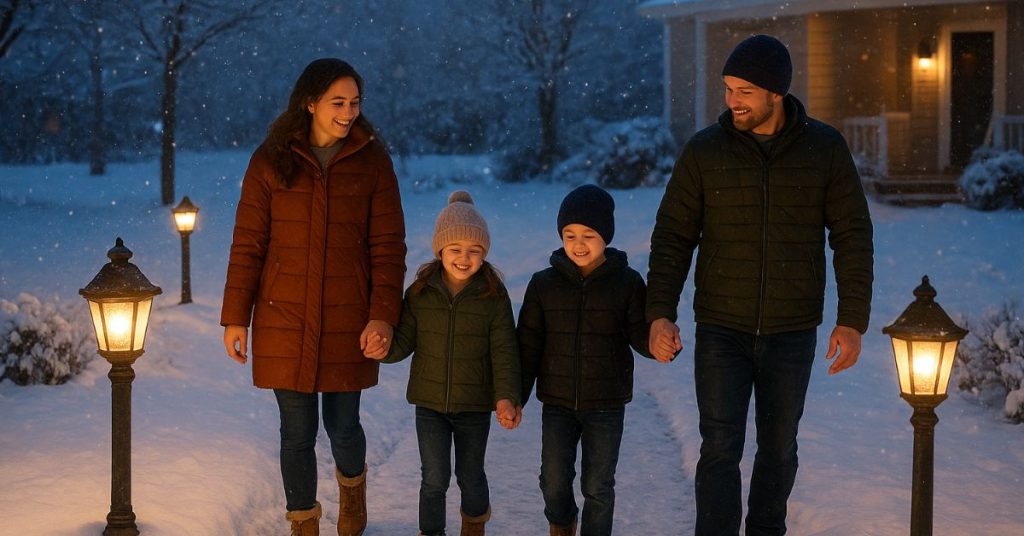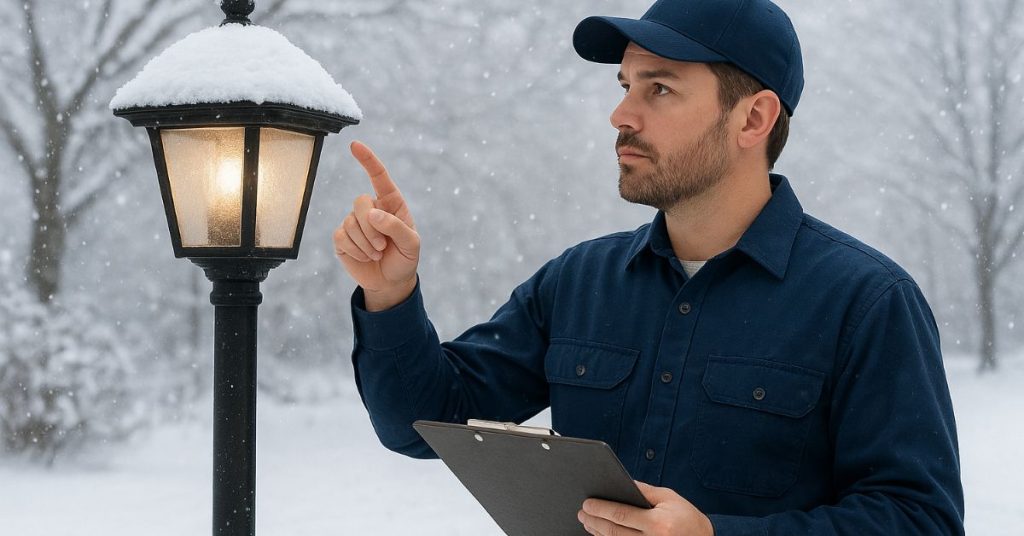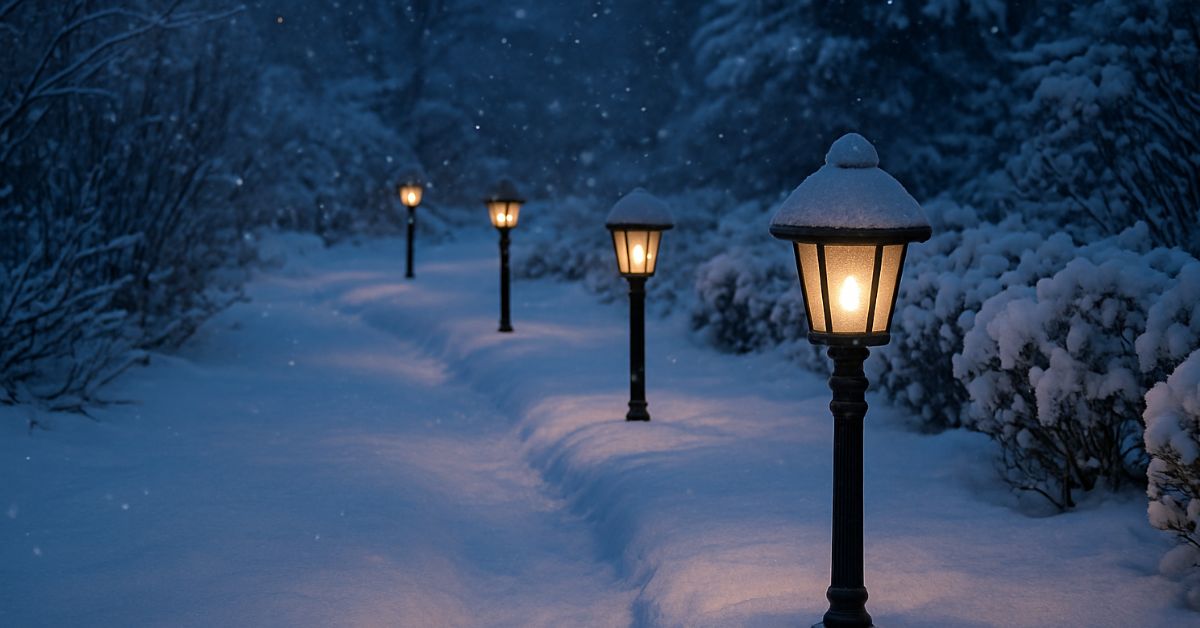Proper outdoor light maintenance during winter ensures safety and visibility. Regularly clean fixtures, replace burnt-out bulbs, check wiring for damage, and clear snow or ice buildup to maintain brightness and prevent electrical issues all season.
Key Takeaways:
- Clean and inspect lights regularly.
- Replace bulbs as needed.
- Keep fixtures free from snow and ice.
- Check wiring for wear or damage.
As temperatures drop and snow begins to blanket the ground, outdoor light maintenance during winter becomes essential to ensure your property remains safe, well-lit, and welcoming. Harsh weather, moisture, and freezing conditions can damage fixtures, corrode wiring, and reduce energy efficiency. Proper care and maintenance can help your LED outdoor lighting for winter endure the cold months while maintaining brightness and reliability.
Why Winter Outdoor Lighting Maintenance Matters

Winter outdoor lighting maintenance is essential as colder temperatures, ice, and snow can damage bulbs, wiring, and fixtures. Without regular attention, lights may flicker, fail, or become obscured by snow and debris, reducing visibility and increasing the risk of accidents on pathways, driveways, and entryways. Ensuring your lighting system is in top condition keeps your property safe and inviting during the long winter nights.
Professional care, including fixing outdoor lights in cold weather, helps prevent permanent damage and prolongs the lifespan of fixtures. Regular inspections, cleaning, and timely bulb replacements ensure reliable illumination, deter potential intruders, and maintain the aesthetic appeal of your home or business throughout the season.
Inspect All Outdoor Fixtures Before Freezing Temperatures Set In
Before the first frost, it’s crucial to inspect your outdoor lighting system thoroughly. Look for cracks, loose fittings, or exposed wires. Any damage can worsen during cold months, leading to costly repairs later. Check for:
- Moisture accumulation inside light covers.
- Corrosion or rust on metal parts and screws.
- Frayed or damaged electrical wires.
Replacing damaged parts early helps prevent short circuits and ensures the system can withstand winter’s challenges. To further protect your home from potential electrical hazards, make sure to check these electrical preventative maintenance tips every homeowner needs to keep your system safe and efficient year-round.
Clean Fixtures and Remove Debris Regularly
Over time, dirt, dust, and leaves accumulate around outdoor lights. During winter, this buildup can mix with snow and ice, creating layers that block illumination. Use a soft cloth or non-abrasive cleaner to wipe lenses and fixtures gently. Avoid using harsh chemicals, as they can damage finishes or seals. Keeping your fixtures clean not only enhances brightness but also extends the lifespan of your bulbs and housings.
Use Weatherproof and Energy-Efficient Bulbs
Not all bulbs are made for cold weather. When preparing your outdoor lights for winter, choose weather-resistant, energy-efficient bulbs such as LEDs. These bulbs consume less electricity, last longer, and are more resistant to temperature fluctuations. Look for bulbs labeled for outdoor or wet-location use, ensuring they can handle rain, snow, and frost without failure. LEDs also provide consistent brightness, even when temperatures plummet below freezing.
For more guidance on choosing the right bulbs and maximizing energy efficiency, see Energy.gov’s Lighting Choices guide.
Opt for Solar-Powered Holiday Lights
For the ultimate energy-efficient option, consider solar-powered holiday lights. These lights use sunlight to recharge during the day and illuminate your home at night—completely eliminating the need for electrical power.
Solar lights work best in outdoor areas with adequate sun exposure, such as gardens, driveways, and patios. Not only do they cut down your energy costs, but they also offer flexibility, as you won’t need extension cords or power outlets.
Check and Seal Electrical Connections
Moisture is the biggest threat to your outdoor electrical systems in winter. It can cause corrosion and short circuits if not properly managed. Make sure all electrical connections are tightly sealed using waterproof connectors or weatherproof junction boxes. Applying dielectric grease to connections adds an extra layer of protection against moisture intrusion. Inspect extension cords, timers, and sockets for wear, and replace them with heavy-duty, outdoor-rated options.
Keep Snow and Ice Away from Fixtures
Accumulated snow can obstruct light beams, while ice can damage housings and lenses. Regularly clear snow and ice from your lighting fixtures using a soft brush or broom. Never use metal tools, as they may scratch or break the fixture’s surface. When shoveling walkways or driveways, avoid piling snow near lights to prevent accidental damage. Proper clearance allows lights to function efficiently and ensures pathways stay illuminated throughout the season.
Adjust Timers and Motion Sensors for Winter Conditions
Winter days are shorter, and lighting schedules must adapt to earlier sunsets and later sunrises. Review and adjust your timers accordingly to ensure lights activate at the right time. If your system includes motion sensors, clean their lenses and ensure they are free from snow or dirt that may affect performance. Sensors often become less responsive in extreme cold, so testing and recalibration are vital for consistent operation.
Protect Lighting Fixtures from Freezing Conditions
Even high-quality outdoor lights can suffer in extreme cold. Shield delicate fixtures with protective covers or housing units that provide insulation. If possible, use fixtures rated for sub-zero temperatures. For decorative string lights or garden illumination, opt for weather-sealed cables that resist cracking and hardening. Taking these steps minimizes the risk of brittle wiring and breakage when temperatures drop below freezing.
Maintain Proper Drainage Around Fixtures
Standing water can freeze and damage light fixtures and wiring. Ensure the ground around your outdoor lighting has proper drainage to prevent water from pooling. Elevate low-lying fixtures or install gravel bases to improve runoff. This small adjustment helps prevent corrosion, water intrusion, and the formation of ice that can crack lenses or enclosures.
Schedule Routine Inspections Throughout the Season

Winter maintenance isn’t a one-time task. Schedule periodic checks throughout the season to monitor the condition of your outdoor lighting system. Look for flickering bulbs, uneven illumination, or signs of electrical issues. Replace burned-out bulbs immediately, as leaving them unattended can strain the rest of the circuit. Consistent care ensures your lights perform reliably from the first frost to the final thaw.
Upgrade to Smart Lighting Controls for Convenience
Modern technology offers smarter solutions for winter lighting. Smart outdoor lighting systems allow you to control fixtures remotely, adjust brightness levels, and receive maintenance alerts through a mobile app. These systems can automatically adapt to daylight changes, saving energy and extending bulb life. Investing in smart lighting ensures convenience and efficiency, even during the coldest months.
Apply a Layer of Protective Coating for Longevity
To extend the lifespan of your fixtures, apply a protective silicone or acrylic coating to metal parts. This barrier shields against corrosion caused by snow, salt, and moisture. For coastal or high-humidity areas, consider powder-coated or stainless steel fixtures for maximum resistance to winter weather conditions.
Common Winter Outdoor Lighting Problems and How to Fix Them
Even with preventive measures, issues can arise during winter. Some common problems include:
- Flickering lights: Caused by loose connections or moisture buildup, leading to intermittent illumination issues.
- Tripped breakers: Overloading circuits or water infiltration can frequently cause breakers to trip unexpectedly.
- Dim illumination: Aging bulbs or snow covering fixtures can reduce the brightness of your lights.
- Burnt-out bulbs: Cold temperatures can shorten bulb life, requiring timely replacements for proper lighting.
- Corroded or rusted fixtures: Ice and moisture exposure damages metal components, affecting lighting functionality.
- Broken or cracked covers: Snow, ice, or debris can crack covers, allowing water to reach electrical parts.
Addressing these issues promptly ensures your system continues to perform safely and efficiently.
When to Call a Professional for Winter Outdoor Lighting
Some outdoor lighting problems are best handled by professionals, especially when exposed wiring, flickering, or recurring electrical issues occur. Attempting DIY fixes in freezing conditions can be risky and may cause further damage to fixtures or wiring.
The Electricians Service Team specializes in outdoor holiday lighting installation, thorough inspections, repairing damaged wiring, and applying weatherproof seals. Hiring experts ensures your lighting system stays safe, reliable, and fully operational throughout winter, giving you peace of mind and long-lasting illumination.
Don’t wait until a small issue becomes a costly repair—contact us today!
Final Thoughts: Keep Your Outdoor Lights Bright All Winter
Proper outdoor light maintenance during winter is essential for safety, visibility, and curb appeal. Regular cleaning, replacing bulbs, sealing connections, and keeping fixtures free of snow and ice ensures your system operates efficiently despite harsh weather.
For complex issues or preventative care, the Electricians Service Team provides professional electrical services to handle inspections, repairs, and installation. Protect your investment and enjoy worry-free illumination all season long.
Book now to schedule a professional winter lighting checkup and keep your property shining bright!
FAQs
You should inspect fixtures at least once a month during winter. Frequent checks prevent snow, ice, or moisture damage before small issues become costly problems.
No, regular bulbs may fail in freezing temperatures. Use weatherproof or LED bulbs designed specifically for outdoor cold-weather conditions.
Use a soft brush or broom to gently remove snow and ice. Avoid metal tools to prevent scratching or cracking the fixtures.
Yes, smart systems adjust automatically to shorter daylight hours and extreme weather. They also allow remote control and maintenance alerts for convenience.
Call a professional if you notice flickering lights, exposed wiring, or electrical issues. Seasonal inspections by experts prevent damage and extend fixture lifespan.





